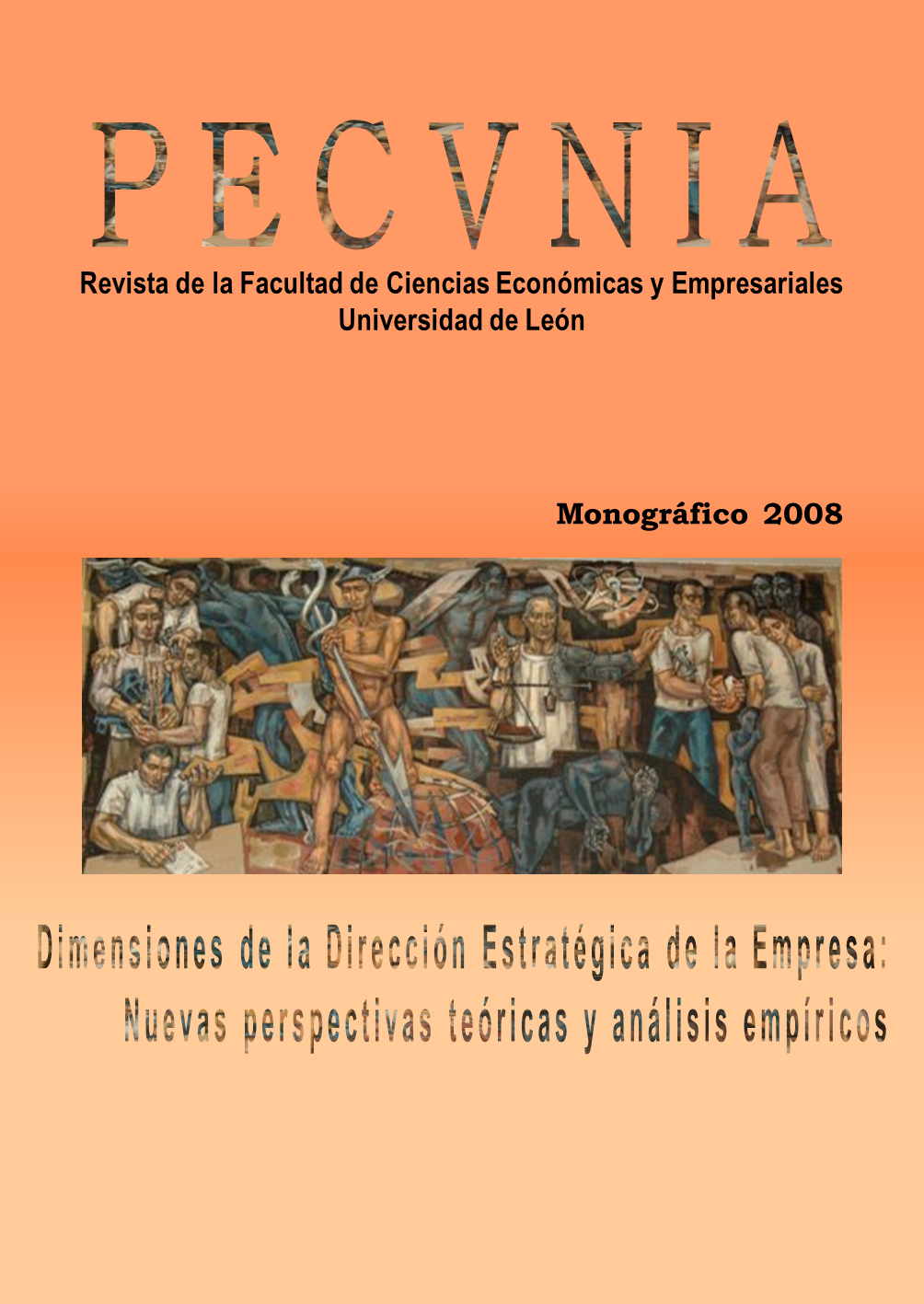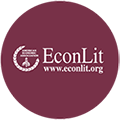Análisis de los factores determinantes de la eficacia organizativa desde la dirección estratégica de recursos humanos
DOI:
https://doi.org/10.18002/pec.v0i2008.791Palabras clave:
Prácticas de recursos humanos de alto compromiso, Resultados corporativos, High commitment human resource practices, Firm performanceResumen
La dirección estratégica de recursos humanos enfatiza la influencia de las prácticas de recursos humanos de alto compromiso sobre la eficacia organizativa. El objetivo de este trabajo es contrastar como el empleo de un conjunto de prácticas de recursos humanos de alto compromiso en el seno de una organización influye positivamente en los resultados que ésta consigue. Para ello, se dispone de una muestra de 258 empresas manufactureras españolas. Los resultados apuntan que la utilización de dichas prácticas de recursos humanos tiene un impacto positivo sobre los rendimientos corporativos. De esta forma, este trabajo aporta evidencia empírica para la relación entre las prácticas de recursos humanos de alto compromiso consideradas de forma global y el rendimiento organizativo para el caso de una gran muestra de empresas españolas pertenecientes a todos los sectores de actividad industrial, lo cual supone una avance importante en la investigación sobre recursos humanos en España donde existe una laguna importante de trabajos empíricos que aborden esta cuestión.Strategic human resource management highlights the influence of the high commitment human resource practices on firm performance. The aim of this study is to analyse how the use of high commitment human resources practices influences, in a positive way, on the firm performance. For this purpose, a sample of 258 Spanish manufacturing companies has been used. The results indicate that the use of the raid human resources practices have a positive impact on corporate performance. In this way, the main implication of this study is that provides empirical evidence for Spanish firms of the relationship between high involvement human resource practices and performance. This represents a significant advance in human resources research in Spain, where there is a significant gap in empirical work studying this subject.
Descargas
Citas
APRIL CHANG, W.J. and T. CHUN HUANG (2005) "Relationship between Strategic Human Resource Management and Firm Performance: A Contingency Perspective", International Journal of Manpower, Vol. 26, 5, pp. 434-
ARTHUR, J. (1992) "The Link between Business Strategy and Industrial Relations Systems in American Steel Minimills", Industrial and Labour Relations Review, Vol. 45, pp. 488-506.
ARTHUR, J. (1994) "Effects of Human Resource Systems on Manufacturing Performance and Turnover", Academy of Management Journal, Vol. 37, pp. 670-687.
BAE, J. and J.J. LAWLER (2000) "Organizational and HRM Strategies in Korea: Impact on Firm Performance in an Emerging Economy", Academy of Management Journal, Vol. 43, pp. 502-517.
BALINGA, B.R.; R.C. MOYER and R.S. RAO (1996) "CEO Duality and Firm Performance: what's the Fuss?", Strategic Management Journal, Vol. , pp. 41-43.
BARNEY, J.B. and P.M. WRIGHT (1998) "On Becoming a Strategic Partner: The Role of Human Resources in gaining Competitive Advantage", Human Resource Management, Vol. 7, 1, pp. 31-46.
BARTEL, A.P. (1994) "Productivity Gains from the Implementation of Employee Training Programs", Industrial Relations, Vol. 33, pp. 411-425.
BECKER, B.E. and M.A. HUSELID (1998) "High Performance Work Systems and Firm Performance: A Synthesis of Research and Managerial Implications", Research in Personnel and Human Resources Journal, Vol. 16, 1, pp. -101.
CHEN, L.H.; S.Y. LIAW and T.Z. LEE (2003) "Using an HRM Pattern Approach to Examine the Productivity of Manufacturing Firms: An Empirical Study", International Journal of Manpower, Vol. 24, 3, pp. 299-318.
CUTCHER-GERSHENFELD, J.C. (1991) "The Impact on Economic Performance of a Transformation in Workplace Relations", Industrial and Labour Relations Review, Vol. 44, pp. 241-260.
DATTA, D.K.; J.P. GUTHRIE and P.M. WRIGHT (2005) "Human Resource Management and Labor Productivity: Does Industry Matter", Academy of Management Journal, Vol. 48, pp. 135-145.
DELANEY, J.T. and M.A. HUSELID (1996) "The Impact of Human Resource Management Practices on Perceptions of Organizational Performance", Academy of Management Journal, Vol. 39, pp. 949-969.
DELERY, J.E. and D.H. DOTY (1996) "Modes of Theorizing in Strategic Human Resource Management: Tests of Universalistic, Contingency and Configurational Performance Predictions", Academy of Management Journal, Vol. 39, pp. 802-835.
DELERY, J.E. and J.D. SHAW (2001) "The Strategic Management of People in Work Organizations: Review, Synthesis and Extension". K.M. ROWLAND and G.R.
FERRIS (Eds.) Research in Personnel and Human Resource Management. Greenwich, CT: JAI Press, pp. 165-197.
DUNS AND BRADSTREET ESPAÑA (2001) Duns 50.000 Principales Empresas Españolas, Madrid.
GERHART, B. (1999) "Human Resource Management and Firm Performance: Measuring Issues and their Effect on Causal and Policy Inferences". P.M. WRIGHT, L.D. DYER, J.W. BOUDREAU and G.T. MILKOVICH (Eds.) Research in Personnel and Human Resource Management. Greenwich, CT: JAI Press, Supplement 4, pp. 31-51.
GUTHRIE, J.P. (2001) "High Involvement Work Practices, Turnover and Productivity: Evidence from New Zeland", Academy of Management Journal, Vol. 44, pp. 180-191.
HILL, C.W.L.; M.A. HITT and R.E. HOSKISSON (1992) "Cooperative versus Competitive Structures in Related and Unrelated Diversified Firms", Organization Science, Vol. 3, 4, pp. 501-521.
HOLZER, H.J. (1987) "Hiring Procedures in the Firm: Their Economic Determinants and Outcomes". M.M. KLEINER, R.N. BLOCK, M. ROOMKIN & S.W. SALSBURG (Eds.) Human Resources and the Performance of the Firm. Washington, DC: BNA Press.
HUSELID, M.A. (1995) "The Impact of Human Resource Management Practices on Turnover, Productivity, and Corporate Financial Performance", Academy of Management Journal, Vol. 38, pp. 635-670.
HUSELID, M.A. and B.E. BECKER (1997) "The Impact of High Performance Work Systems, Implementation Effectiveness, and Alignment with Strategy on Shareholder Wealth", Unpublished paper, New Brunswick, NJ: Rutgers University.
ICHNIOWSKI, C.; K. SHAW and G. PRENNUSHI (1997) "The Effects of Human Resource Management Practices on Productivity: A Study of Steel Finishing Lines", American Economic Review, Vol. 87, pp. 291-313.
KATZ, H.C.; T.A. KOCHAN and K.R. GOBEILLE (1983) "Industrial Relations Performance, Economic Performance and QWL Programs: An Interplant Analysis", Industrial and Labour Relations Review, Vol. 37, pp. 3-17.
KING, A.W. and C.P. ZEITHAML (2001) "Competences and the Firm Performance: Examining the Causal Ambiguity Paradox", Strategic Management Journal, Vol. 22, pp. 75-99.
KOCH, M.J. and R.G. MCGRATH (1996) "Improving Labour Productivity: Human Resource Management Policies do Matter", Strategic Management Journal, Vol. 17, pp. 335-354.
KOCHAN, T.A. and P. OSTERMAN (1994) The Mutual Gains Enterprise. Boston, MA: Harvard Business School Press.
LAWLER, E. (1992) The Ultimate Advantage: Creating the High-Involvement Organization. SF: Jossey-Bass.
LEVINE, D. (1995) Reinventing the Workplace: How Business and Employers can Both Win. Brookings Institution Washington, DC.
MACDUFFIE, J.P. (1995) "Human Resource Bundles and Manufacturing: Performance: Organizational Logic and Flexible Production Systems in the World Auto Industry", Industrial and Labour Relations Review, Vol. , pp. 197-221.
MCCARTNEY, J. and P. TEAGUE (2004) "The Diffusion of High Performance Employment Practices in the Republic of Ireland", International Journal of Manpower, Vol. 25, 7, pp. 598-617.
MORISHIMA, M. (1991) "Information Sharing and Firm Performance in Japan", Industrial Relations, Vol. 30, pp. 37-61.
NAMAN, J.L. and D.P. SLEVIN (1993) "Entrepreneurship and the Concept of Fit: A Model and Empirical Tests", Strategic Management Journal, Vol., pp. 137-153.
PFEFFER, J. (1994) "Competitive Advantage Trough People", California Management Review, Vol. 36, pp. 9-29.
PFEFFER, J. (1998) The Human Equation: Building Profits by Putting People First. Boston, MA: Harvard Business School Press.
PODSAKOFF, P. and D. ORGAN (1986) "Self-Reports in Organizational Research: Problems and Prospects, Journal of Management, Vol. 12, pp. 531-544.
POWELL, T.C. (1995) "Total Quality Management as Competitive Advantage: A Review and Empirical Study", Strategic Management Journal, Vol. , pp. 15-37.
RICHARD, O.C. and N.B. JOHNSON (2001) "Strategic Human Resource Management Effectiveness and Firm Performance", International Journal of Human Resource Management, Vol. 12, pp. 299-310.
ROBBINS, S.P. (1990) Organization Theory: Structure, Designs and Applications, Prentice Hall International Editions, 3ª Edition, Englewood Cliffs.
VENKATRAMAN, N. and V. RAMANUJAN (1986) "Measurement of Business Performance in Strategy Research: A Comparison of Approaches", Academy of Management Review, Vol. 11, 4, pp. 801-814.
VENKATRAMAN, N. and V. RAMANUJAN (1987) "Measurement of Business Economic Performance: An Examination of Method Convergence", Journal of Management, Vol. 13, 1, pp. 109-122.
WALTON, R. (1985) "From 'Control' to Commitment in the Workplace", Harvard Business Review, Vol. 73, 2, pp. 77-84.
WELBOURNE, T.M. and A.O. ANDREWS (1996) "Predicting the Performance of Initial Public Offerings: Should Human Resource Management be in the Equation?", Academy of Management Journal, Vol. 39, pp. 891-919.
WHITENER, E.M. (2001) "Do 'High Commitment' Human Resource Practices Affect Employee Commitment? A Cross-Level Analysis using Hierarchical Linear Modelling", Journal of Management, Vol. 27, pp. 515-535.
WIERSEMA, M.F. and K.A. BANTEL (1993) "Top Management Team Turnover as an Adaptation Mechanism: The Role of the Environment", Strategic Management Journal, Vol. 14, pp. 485-504.
WRIGHT, P.M. and G.C. MCMAHAN (1992) "Theoretical Perspectives for Human Resource Management", Journal of Management, Vol. 18, pp. 295-320.
WRIGHT, P.M., G.C. MCMAHAN and A. MCWILLIAMS (1994) "Human Resources and Sustained Competitive Advantage: A Resource-Based Perspective", International Journal of Human Resource Management, Vol. 5, pp. 301-326.
YOUNDT, M.; S. SNELL, J. DEAN and D. LEPAK (1996) "Human Resource Management, Manufacturing Strategy, and Firm Performance", Academy of Management Journal, Vol. 39, pp. 836-886.
Descargas
Publicado
Cómo citar
Número
Sección
Licencia
Derechos de autor 2008 Nuria González Álvarez

Esta obra está bajo una licencia internacional Creative Commons Atribución-NoComercial-CompartirIgual 4.0.
Los autores que publican en esta revista están de acuerdo con los siguientes términos:- Los autores ceden de forma no exclusiva los derechos de explotación (reproducción, distribución, comunicación pública, transformación) a la Universidad de León, por lo que pueden establecer, por separado, acuerdos adicionales para la distribución no exclusiva de la versión de la obra publicada en la revista (por ejemplo, alojarlo en un repositorio institucional o publicarlo en un libro), con un reconocimiento de su publicación inicial en esta revista.
- Este trabajo se encuentra bajo la Creative Commons Attribution-NonCommercial-ShareAlike 4.0 International License. Puede consultarse desde aquí la versión informativa y el texto legal de la licencia.
- Se permite y se anima a los autores a difundir electrónicamente las versiones pre-print (versión antes de ser evaluada) y/o post-print (versión evaluada y aceptada para su publicación) de sus obras antes de su publicación, ya que favorece su circulación y difusión más temprana y con ello un posible aumento en su citación y alcance entre la comunidad académica.












